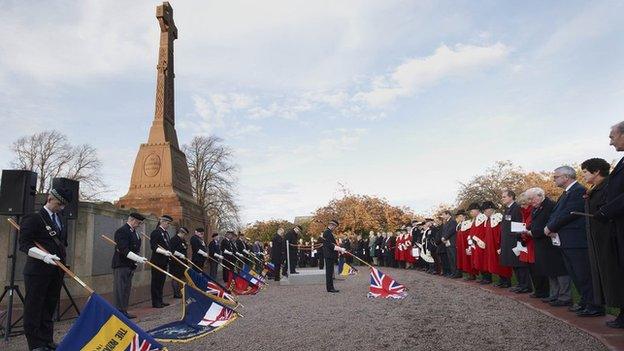Funds for Highland war memorial work 'insufficient'
- Published

One in seven men in Inverness parish died while serving in the forces during World War I from 1914-18
A council lacks the funds to make sure all of its war memorials are in a state fit to mark the centenary of the start of World War I.
In a report to Highland councillors, officers said there was a desire to begin repair work well before the anniversary in 2014.
However, the officials said grant aid would be needed to help cover costs.
The council is responsible for 165 memorials and the cost of repairs has been estimated at £250,000.
Re-lettering names on memorials is expected to require the most money.
Lists of names on the Highland monuments can run to a handful in some places to covering eight plaques in others.
In the paper, officers said: "War memorials aim to keep alive the memory of those in our society and local communities who made the ultimate sacrifice for their country.
"They stand at the heart of almost every community throughout the Highlands, where the numbers lost were disproportionate to most of the rest of the United Kingdom."
But the officials go on to warn: "The current allocation for maintaining war memorials is insufficient to carry out this level of work, especially in a situation where work is likely to be required on a significant number of war memorials to bring them up to the appropriate standard."
Highland's transport, environmental and community services committee will consider the report on Thursday.
In June, the local authority said the names of military personnel killed in conflicts since the end of World War II would be added to a war memorial in Inverness.
Royal British Legion Scotland's Inverness Branch and Highland Council asked families in the city and surrounding area to provide details.
The names will be added to the Cavell Gardens War Memorial.
The memorial on a bank of the River Ness recalls those killed in the two world wars.
With a 10m (33ft) high red sandstone Celtic cross, the memorial was unveiled in 1922.
According to Gaelic heritage website Am Baile, external, one in seven men in Inverness parish died while serving in the forces during World War I from 1914-18.
Cavell Gardens were named after Edith Cavell, a nurse who helped French and British soldiers to flee to Holland during the war.
She was executed by German soldiers in Brussels in October 1915.
- Published14 June 2012
- Published4 September 2011